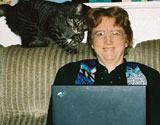In this issue
Home page
-
Features
-
Departments
- Letters
- Campus Views
- News & Notes
- Parents
- Alumni
- Class Notes
- Giving
- Sports
- Aggies Remember
- End Notes
Third floor Mrak Hall
University of California, Davis One Shields Avenue Davis, CA 95616(530) 752-1930
Volume 27 · Number 1 · Fall 2009
Aggies Remember
Dream patient
A most exotic creature helps a vet student slay her fear of large animals.
By Liz J. Andersen, D.V.M. ’79
I grew up a horse-lover, but the closest I ever got to the real thing were Breyers, books and riding lessons in my teens. That was until veterinary school when we were required to rotate through large animal clinics. My experiences with animals as a kid in Silicon Valley were limited to dogs, turtles, cats and a rat, and I planned to become a small animal doctor. I knew just enough about large animals to realize I was totally out of my depth.
The first day of equine handling classes, we divided into small groups around a half dozen horses. We’d barely begun the lesson when our professor interrupted it to race over to a student suddenly down on the lawn. His face was pale and his arm was broken, a bit like the griffin-handling scene in Harry Potter and the Prisoner of Azkaban. But my classmate’s injury was very real, and our horrified teacher made sure we understood the risks of what we were doing.
I considered my veterinary school large animal experiences a matter of brute survival. As a small-animal track student, I suspect that I earned the grudging respect of experienced large animal techs only by admitting I didn’t know what I was doing and by carefully listening to them and following their advice.
My first equine patient tried to kill me. A cardiology case, he was royally sick of diuretic injections. Fortunately, I knew better than to stand behind him, or I would have been crushed between his hooves and the back wall. I don’t know who gave the horse his shot that morning, but it wasn’t me. I couldn’t get near him. Instead I carefully backed out of his stall, full syringe still in my shaking hands.
Luckily, the bull assigned to me after that was so huge and formidable that I was never expected to touch him. I dutifully eyeballed him and wrote “BAR” (Bright, Alert, and Responsive) in his chart each day, and skilled technicians carried out his mysterious treatments.
A farm-raised classmate helped me milk my dairy cow, so I wouldn’t be hopelessly late for clinical rounds. While vaccinating a farm herd, I managed to trap a teacher in the cattle chute — more than once. To my dismay, I was immediately assigned 13 horses during my equine surgery rotation. In order to stumble through all my patients’ morning checkups, grooming and treatments before rounds, I had to drive to school so early that flashing intersection lights on Russell Boulevard eased my way. And I’d get home so late after clinics and evening rounds and treatments that I’d fall asleep with my dinner half-eaten.
One night I met the biggest and scariest patient of my senior year. He was almost as large as a Veterinary Medical Teaching Hospital barn, so I had to hospitalize him on the lawn between two of the barns. Luckily for me, he was so depressed I didn’t think he’d try to escape. He just lay there quietly in sternal recumbency, holding up his giant head and staring down at me with his green, saucer-sized eyes.
I stared back, assessing my patient’s condition. His leathery wings were uselessly crumpled by dehydration, which was so severe that I could also dismiss the possibility of being fried by him. He was as green as the grass, and obviously dying. I’d have to figure out how to get IV drugs and enough fluids into him to save his life.
Classmates set up a ladder alongside the animal’s neck. I decided we’d have to do far more than just glove up to remove a hose-sized catheter from its sterile packaging and cleanly insert it into the creature’s jugular vein. We donned surgery gowns, gloves and masks, and lined up along the catheter. I took the business end and climbed up the ladder. School policy expressly forbade us from turning away any animal species, no matter how exotic, and this was just another suffering patient who sorely needed our help.
The next day I told my equine ambulatory instructor about my dream of having to treat a dragon in shock. She knew I was a small-animal track student, and she laughed and winced. Then she apologized for leaving me alone the previous day with a backyard horse that needed fluids.
I almost laughed back. A lethargic horse! I assured her it wasn’t a problem. It seemed to me I’d finally come to some terms with scary patients.

Liz Andersen lives with her husband, Brian, and their cat, Tom Waits, in Eugene, Ore. When she’s not practicing veterinary medicine, she likes to translate her experiences into science fiction
